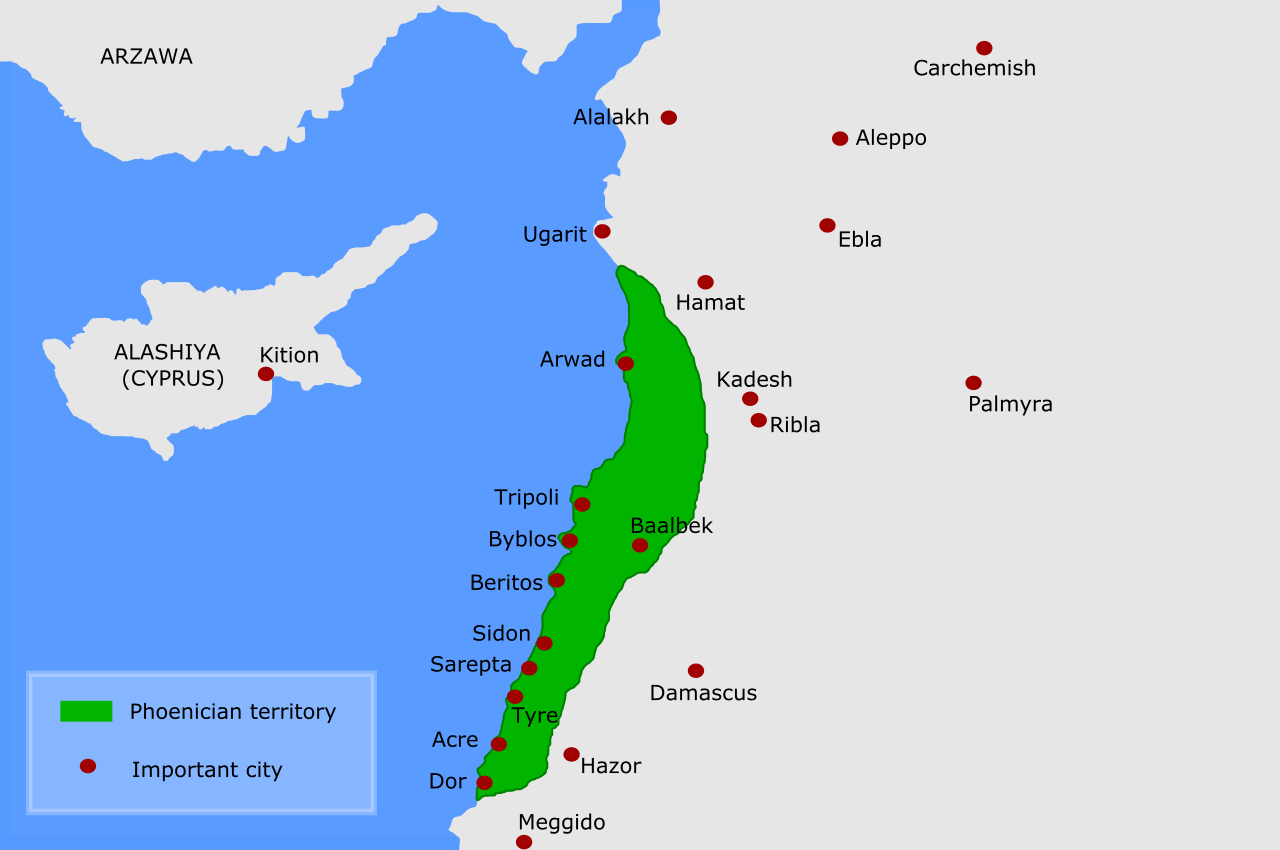Sidon, while a shadow of its former self, is still extant today in Lebanon. Sidon was inhabited well before the Bronze Age, but its residents during the Biblical period were the well known “Phoenicians”. The name “Phoenicia” was actually a Greek, or possibly Egyptian, exonym not native to the people of the region who had no unified term for their collective alliance of city states due to the informal nature of the unification. Typically, residents of “Phoenicia” would go by terms referring to their birth city as evidenced by the inclusion of “Sidon”, the capital city of the Canaanites, rather than any ethnic term. Sidon was, in effect, the birth city of “Phoenicia”, and thus listed as the primary representative of the people.
Sidon’s premier position as the wealthiest, and likely most populous city in the Levant, or Canaan, gave it the designation as Canaan’s “first son”, which was only later eclipsed by Tyre during the time of the Judges, dated after the period of the Torah where they are mostly referred to as Sidonians. Tyre and Sidon operated as effective co-capitals in the Iron Age, with Tyre becoming known for its production of the dye famously called “Tyrian Purple” used as the royal color of the Egyptians, Greeks and Romans. However, the dye was not Phoenicia’s only export.
Equally critical, and possibly more important, was the Phoenician trade in lumber, attested to in the stories of Gilgamesh where he slays the Humbaba in the Lebanese Cedar forests. Both Mesopotamians, and Egyptians, actually completely lacked a supply of lumber, and were forced to use the Levant as their primary supply. Without this resource, there would be no ships, wooden spears, bows and arrows, etc. The importance of the dyes “royal” quality and the region's productive lumber export effectively gave Sidon, Tyre, and the Phoenicians, a complete monopoly over ancient trade, being the oil that fueled many royal dynasties' claims of nobility and military superiority.
Both Tyre and Sidon operated with a very close relationship, unlike the “third capital” of Byblos, which developed a distinct dialect separate from the dominant Tyro-Sidonian dialect that forms the basis of the Phoenician language corpus.1 Many readers will already know of the Phoenician languages revolutionary improvements for writing, completely changing the original Egyptian Hieroglyphic system to one of Semitic Abjads. This system influences everyone, quite literally, from the Greeks to the Etruscans, who passed it on to the Romans which influenced every Romance language and the development of every European writing system.
Interestingly, the Torah actually provides a reference to the Phoenician language, being a rare example of a specific calling out of a people's tongue. We get the line in Deuteronomy 3:9 where it says “The Sidonians call Hermon Sirion; and the Amorites call it Senir.” Not only does this help verify both Phoenician and Amorite as separate languages, and thus Canaanite peoples, it actually gives us an early rendering of the term “Syria” through the Sidonian/Phoenician name for Hermon, termed “Sirion.”
While not a native term, the name for Sidon in Egyptian records from the Ramessid period was “Djedouna”.2 When pronounced in the right way this name is strikingly similar to the name “Judea” and may imply a deeper connection of these terms than scholarship likes to assume. It is also around this era that the close relationship between Hiram, King of Tyre and Solomon had begun to flourish showing a shared lineage in some sense, as it’s doubtful David wasn’t marrying a few Phoenician princesses.
Ultimately the Sidonians are not “Sidon” the city, but the entire Phoenician peoples that never had a good unified term. While one might presume the search ends here the actual historical nature of the Phoenicians is a critical one to analyze.
When discussing Phoenicians it is impossible not to mention their insane network of colonial possessions that enabled their domination of international trade. Most prominent among these was the city of Carthage which later split into its own verifiable Empire competing for domination of the Mediterranean with the Roman Republic. While the Carthaginians were technically termed “Punic” their cultural backbone was identical to the Phoenicians and the inhabitants of Tyre and Sidon would have seen no functional difference between the Carthaginians and themselves.
Conspicuous is the endogamous name Chanani which became the term used by the Cathaginian Punics of North Africa all the way until the Roman Empire. Obviously, this name harkens back to the Canaanites, and thus Sidonians. Indeed, the legendary Tyrian Queen Dido is said to have founded the city, likely sometime around 814 BCE, around the same time as the Judean Kingdom (non-unified monarchies) flourished.
The lack of a distinct mention of Carthage would imply Carthage fits inside one of the Canaanite boxes, rather than having formed their own identity. As discussed prior, the actual Table of Nations opens the Torah, sometime around the collapse of the Bronze Age, and finishes off with the Babylonian Captivity, in the 500s, by which point the Carthaginians would have just begun to overtake the Tyrians as the primary city of Phoenician culture. Thus, the Carthaginians would have been left off the table, and viewed likely as a subset of Sidon that only becomes relevant in the Greek/Roman periods.
Link to the next post
That wraps up this weeks portion of Phoenicians. Comments, shares, and likes are as usual extremely helpful. Thank you for reading.
Charles R. Krahmalkov. Phoenician-Punic Dictionary. p. 10. 2000.
Gauthier, Henri (1929). Dictionnaire des Noms Géographiques Contenus dans les Textes Hiéroglyphiques Vol. 6. p. 138.








